 |
The BMW E30 is the second generation of BMW 3 Series, which was produced from 1982 to 1994. The initial models used the coupe (two-door sedan) body style, with four-door sedan models introduced in 1983, convertibles introduced in 1985 and wagon/estate models (marketed as "Touring") introduced in 1987.
The E30 was the first 3 Series to be available in wagon and four-door sedan body styles. It was also the first 3 Series to have a diesel engine option. All-wheel drive was introduced to the 3 Series range with the 325iX model. The BMW Z1 roadster was based on the E30 platform.
Development of the E30 3 Series began in July 1976, with styling being developed under chief designer Claus Luthe. In 1978, the final design was approved, with design freeze (cubing process) being completed in 1979. The car was released at the end November 1982.[8][1][9][10](p117)
Externally, the E30's appearance is very similar to twin headlight versions of its E21 predecessor, however there are various detail changes in styling to the E30. Major differences to the E21 include the interior and a revised suspension, the latter to reduce the oversteer for which the E21 was criticised.[11]Like the E21, a Baur convertible was available.
Engines[edit]
Initially, the E30 models used the M10 straight-four and the M20 straight-six engines, like its E21 predecessor.[14] Over the production run, the M10 was replaced with the M40 and M42, the M20 received various upgrades and the S14 engine was introduced in the M3.
A six-cylinder diesel was also introduced later, in both naturally aspirated and turbocharged forms.
Four-cylinder[edit]
At the launch of the E30 range in 1982, the 316 used a 1766 cc M10 fed by a carburetor and producing 66 kW (89 hp).[15][16] The 318i had the same M10 engine, but with Jetronic fuel injection, pushing power to 77 kW (103 hp)[17][16] while also improving fuel economy.
The 1987 Series 2 update introduced a new four-cylinder engine: the M40, which used Motronic fuel-injection. In the 318i, a 1,796 cc (109.6 cu in) version of the M40 was used. The 316i model replaced the 316, using a 1,596 cc (97.4 cu in) version of the M40.
The 318iS coupe was released in 1989, using the new M42 engine.[18][19] This is the most modern engine available in the E30 range, incorporating DOHC, the updated Bosch Motronic 1.3, hydraulic valve adjusters and coil-on-plug ignition. In some markets, the M42 engine was used in the 318i (sedan) and 318iC (convertible) models, instead of the M40.
The M3 is powered by the S14 engine, a high-revving motorsport engine with a cylinder head derived from the M88 six-cylinder engine.[20][21]
Six-cylinder[edit]
Petrol[edit]
At the launch of the E30 range, the six-cylinder models consisted of the 320i, which had a 2.0 L (120 cu in) M20 engine producing 92 kW (123 hp),[22] and the 323i, with a 2.3 L (140 cu in) M20 making 102 kW (137 hp),[1][16] both using Bosch L-Jetronic fuel injection. These models were not sold in North America, presumably for emissions reasons. In 1985, the 2.3 L engine was replaced with a 2.5 L version of the M20, which produced 126 kW (169 hp) and used Bosch Motronic fuel injection.[23][24] This engine was available in the 325i variants, including the all-wheel drive 325iX.
An economy version called the 325e was released as a lower revving, more fuel efficient engine. The e is an abbreviation for eta, which is used to represent the thermal efficiency of a heat engine. To maximise low-rev torque, the engine was the largest available in an E30, aside from the South Africa-only 333i model. The 2.7 L (160 cu in) engine had a longer stroke than the 2.5 L, with a more restrictive head, four cam bearings instead of seven (less internal friction), and single valve springs (instead of the dual valve springs used by the 2.5 L engine). This resulted in 90 kW (120 hp) at 4250 rpm and, more importantly, 240 N⋅m (180 lb⋅ft) at 3250 rpm.[25][24] (without catalytic converter) Peak torque for the 2.5 L (150 cu in) engine is 215 N⋅m (159 lb⋅ft) at 4000&nbp;rpm).
The 1987 Series 2 update boosted the 320i to 95 kW (127 hp) and the 325i to 126 kW (169 hp), and improved fuel economy.[26][27]
Diesel[edit]
In 1983 the 324td was unveiled at the IAA, Germany. The M21 diesel straight-six engine was turbocharged using a Garrett turbocharger, but without intercooler. The engine has a capacity of 2,443 cc (149 cu in) and uses mechanical (indirect) fuel injection.
In 1985 BMW introduced the 324d, a naturally aspirated version of the same M21 engine, which was popular in countries with a high motor vehicle tax.[28]
In 1987 an electronically controlled fuel pump was used[29][30] which increased the torque output by 10 N⋅m (7 lb⋅ft). The updated engine has a smaller turbocharger, decreasing turbo lag.
Suspension[edit]
One of the features that added to the roominess of the E30 was the suspension. The front MacPherson struts and rear semi-trailing arm suspension were a compact arrangement that left a lot of cabin and boot space for the car's overall size. The semi-trailing arms have been criticized for the dynamic toe and camber changes inherent to the suspension geometry, causing bump steer in hard cornering situations (such as racing and autocross). Nonetheless, reviewers praised the handling of the E30.[40][41][42]
A widened version of the E30 front suspension and the drivetrain from the E30 325i were used in the BMW Z1 roadster. The BMW Z3 (E36/4) and BMW Compact (E36/5) rear suspensions are also very similar to the E30, but utilizing five-lug hubs. The Z3-based BMW M Coupe uses a widened version of the same rear semi-trailing arm suspension.
Brakes[edit]
For the front wheels, all models use disk brakes. For the rear wheels, most models use disk brakes, except for some 4-cylinder models which use drum brakes. Anti-lock braking system (ABS) became available in 1986.
M3[edit]
The BMW M3 utilised a widened and heavily redesigned variation of the coupe body style, therefore the M3 shares few body parts with other E30 models.[11] The M3 suspension is also significantly different from regular E30 models,[37] including five-lug wheel bolts.
Special models[edit]
Alpina[edit]
The Alpina C1, C2, B3 and B6 models were based on the E30.
320is[edit]
For Portugal and Italy only, due to considerably higher VAT and vehicle tax for cars with engines exceeding 2000 cc, a special model was created: the 320is.[61] The sedan version appeared in the dealers' showrooms in September 1987 while the coupe version arrived in March 1988. Production of the 320is continued until 1991.
This model was produced both in coupe and sedan versions and was equipped with a 1,990 cc (121 cu in) version of the S14 engine from the M3, with stroke reduced to 72.6 mm (2.86 in).[62] This engine produced 143 kW (192 hp) at 6900 rpm and 155 lb⋅ft (210 N⋅m) at 4,900 rpm.[62] The 320is shared the same dogleg Getrag 265 gearbox of the non-US M3 while it had a limited slip differential with the same 25% lock up rate but with a shorter differential ratio of 3.46:1.[63] All the 320is models were left hand drive and without a catalytic converter. Sports suspension was fitted to all coupes, and to sedans produced from September 1989.
The interior of the 320is was identical to that of other 3 Series models, except an M3 instrument cluster (which features an oil temperature gauge instead of a fuel economy gauge) was used. The 320is was sold for three years, with 1,206 sedans and 2,542 coupes produced.[64]
M325i[edit]
In New Zealand, where the M3 was never sold by BMW, the local importer created a sporting version of the sedan called M325i. About 100 such cars were imported beginning in late 1986 until at least 1990.[65] Fitted with the standard non-catalyzed 126 kW (171 PS) 2.5 litre engine they benefitted from a Motorsport tuned suspension, the M-Technic body package, 15-inch BBS cross-spoke wheels with wide, low profile (225/50) tyres, and a limited-slip differential.[65] The M325i is quite similar to the British market 325i Sport, also developed as a response to the absence of a right-hand-drive M3.
333i[edit]
BMW South Africa's Motorsport division created the 333i in 1985 by fitting the 3.2 L M30 "big six" engine to a coupe E30.[66] The resulting 333i was a success in South African saloon car racing. These cars were built with help from Alpina in Buchloe, Germany.[67][68] Due to the space constraints caused by the large M30 engine, the buyer was forced to choose between air conditioning (vital in South Africa) and power steering. The 333i was produced from 1985 to 1987 and only 204 cars were produced.[69]
The 333i engine produces 145 kW (194 hp) at 5500 rpm and 285 N⋅m (210 lb⋅ft) at 4300 rpm.[69] BMW's official performance claims are 0–100 km/h (0–62 mph) in 7.4 seconds, and a top speed of 228 km/h (142 mph).[70]
South African 325iS[edit]
The 2.7 litre 325iS, commonly called Evo 1, was created by BMW South Africa to replace the 2.5 litre 126 kW 325i in Group N production car racing, as a response to the introduction of the Opel Kadett 2 litre 16V to the Class A category. It was launched in the first half of 1990 and was powered by an Alpina-fettled, 2.7 litre M20 engine which produced 145 kW (194 hp).[71] Following the introduction of the upgraded Opel Kadett 16V SuperBoss, in 1991 BMW South Africa introduced the 325iS Evolution HP, commonly referred to as the Evo 2. The motor was upgraded to produce 155 kW (208 hp).[71]
The Evolution HP won the Group N Class A title in 1993, winning 20 of the 24 races in the process.[72] The Robbi Smith and Geoff Goddard Evolution HP won the season-ending 9hr race.[73]
323i JPS[edit]
The JPS Edition is an Australian-only model built as a tribute to the 635CSi cars competing in local touring car racing. JPS refers to the race sponsor, John Player Special cigarettes. The cars are 323i manual coupes,[74] painted in black with gold pinstripes and gold BBS wheels. They also had Recaro sports seats, JPS badging, a limited slip differential, sports suspension, a sunroof and a body kit.[75] The initial production run was 70 cars, with a small number of additional cars produced afterwards.[75]
Model year changes[edit]
Minor update (1985)[edit]
In 1985 the exterior and interior trim were updated. The 323i model was replaced with the 325i at this time and the diesel-engined 324d was introduced.[76] A factory convertible entered the model range. However, the Baur remained on sale, alongside the factory convertible. The M3 convertible was only offered for the European market. The M3 convertible was only sold in Europe.
Major update (1987)[edit]
At the Frankfurt Motor Show in September 1987, BMW introduced a major update to the E30 (often called Series 2).[76][77](pp17,19) The changes to the lineup were the addition of the Touring (station wagon) variant and removal of the 325e model. The M10 4-cylinder engine was replaced by the M40. WP:TRIVIA External styling changes included a new front bumper, redesigned rear lights, rear apron, headlight reflectors, and licence plate frame, while the window frames lost their chrome trim.[77] Rust protection was improved with the update. Various mechanical changes were made, including updating of the engine range. The 1987 update models remained largely unchanged until the end of production.
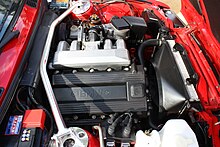
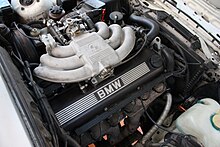
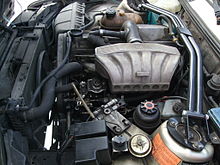
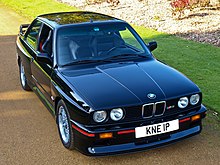
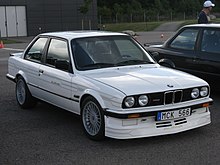
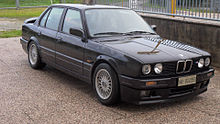
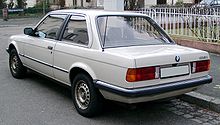


تعليقات
إرسال تعليق
we will soon reply on your comment